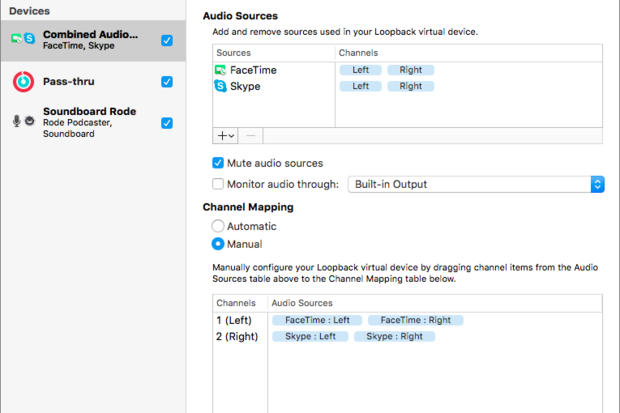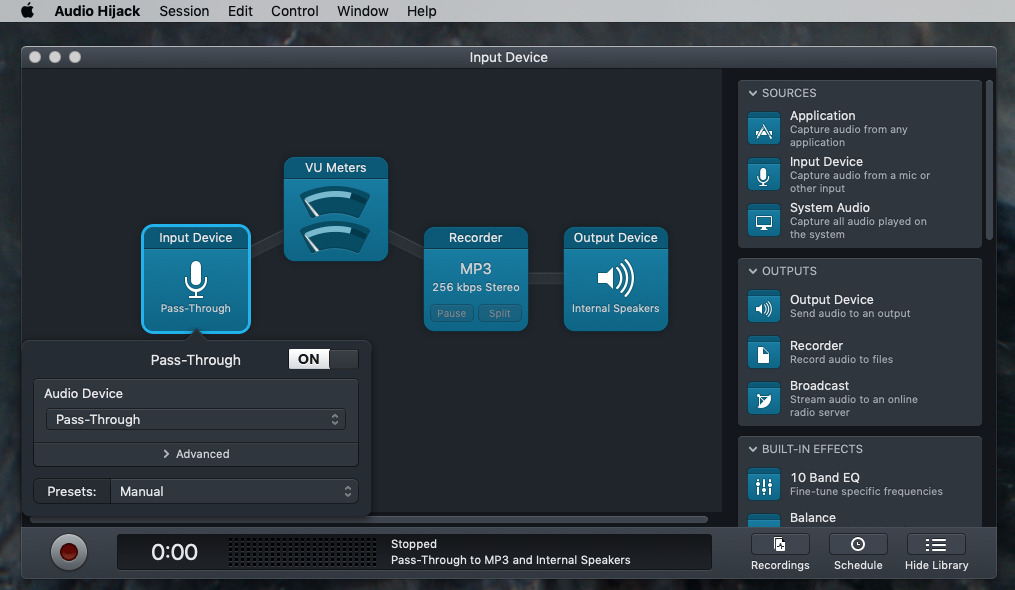

Custom Channel Mapping - By default, Loopback sets up channel mapping automatically.Multichannel Audio - Your virtual audio devices can be configured to have up to 32 channels, providing tremendous power.Combine Apps and Physical Devices - Of course, you can create a virtual audio device that includes audio from both apps and physical audio devices.Whether you’ve got simple USB microphones, or high-end studio mixers, Loopback can access it all. Works With Any Input Device - Pull audio from the physical audio devices connected to your Mac.Works With Any Application - Make a virtual audio device with audio from the applications on your Mac, including production apps like Logic or Reason, as well as simple audio players, like iTunes or QuickTime.Set the Loopback device as the output in one app and the input in another to make audio flow directly between the applications. Send Audio Between Apps - Loopback can also create pass-thru devices, which send audio from one app to another.Find them listed among other devices in System Preferences or select them as an input or output in any audio app.
#MAC LOOPBACK AUDIO MAC#
Available System-Wide - Your Mac will show Loopback's virtual devices exactly like physical devices.Just add the applications and physical audio devices you want to include to the Audio Sources table to get started. Combine Audio Sources - Configuring a virtual audio device from multiple sources is easy.Now listeners can tune in to a live stream of your podcast as you record it! Route Audio For Broadcasts - Set a simple (pass-thru) device as the output at the end of an Audio Hijack chain, and then as the input source in Nicecast.Create a virtual device that grabs just the mic and the app’s audio to get exactly the audio you want. Some allow recording of system audio instead, but neither option is ideal. Create Top-Notch Screencasts - Screen recorders, including QuickTime Player, allow you to include your mic's audio.With Loopback, you can combine multiple input devices into one virtual device for easy recording. Thankfully, they offer recording from many channels. Combine Hardware Devices - Apps like GarageBand, Logic, and Ableton Live only record from a single audio device at once.

If you're using a device like Elgato's Game Capture hardware and you want to record both your microphone and the game's audio at once, Loopback can assist!
#MAC LOOPBACK AUDIO CRACK#
Have to crack those books on it, it's a bit more complicated and less intuitive for simple streams. Since I want to use this to play around with music devices/synths, the real solution is Mainstage. I will investigate putting Audio Hijack into the chain, which principally allows sound capture to a file but also allows dynamic insertion of processing and defining the output device. This is because both apps use the backend in parallel. Although in SoundSource you can select LoopBack as an input app, it actually does not process the audio.

I did run into a caveat that is not well documented. Apart from controlling individual volumes, you can boost levels and insert Audio Unit processing. SoundSource also allows some sound manipulation in its path. AirFoil allows you to capture audio and direct it to AirPlay 1 & 2 devices. Fundamentally this allows redirecting all device or application sounds to a different output via Menu app with SoundSource or creating virtual device audio streams using LoopBack. They all rely on the same backend intercepting Apple's audio system architecture. Rogue Amoeba's tools are a "must-have" for sound lovers.


 0 kommentar(er)
0 kommentar(er)
